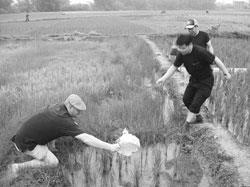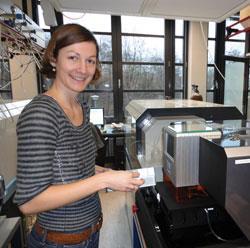The boom in analytical methods for determining the distribution of an element between its different chemical forms is charted by Andy Extance
The boom in analytical methods for determining the distribution of an element between its different chemical forms is charted by Andy Extance
’Baby foods used to wean infants off milk have been found to contain "alarming" levels of toxic contaminants including arsenic, lead and cadmium,’ warned the UK’s Telegraph newspaper on 9 April 2011. ’How can I be standing here in America talking about arsenic in our apple juice?’ exhorted US talk show host Dr Oz on 14 September. ’A new study is raising concerns about the arsenic levels ingested by women who eat as little as half a cup of cooked rice in a day,’ reported USA Today on 6 December.
Toxic elements found in food readily grab media attention for obvious reasons. Yet behind the headlines lies a chemical issue that doesn’t always reach the audience - that the form an element is in determines its toxicity. And not every form of a so-called ’toxic contaminant’ is indeed toxic.
When inductively coupled plasma mass spectrometry (ICP-MS) was commercialised in 1983 and coupled to powerful separation techniques (see box p55), the accuracy with which trace elements could be detected was strongly enhanced. That detection power quickly demonstrated the importance of an element’s speciation - the distribution of its various forms in a system such as a foodstuff - in determining the toxicity of the system.
Scientists soon realised that knowing the element’s chemical forms and oxidation states is essential, recalls Norbert Jakubowski from the BAM Federal Institute for Materials Research and Testing, Berlin, Germany. ’For example, they found out that Cr3+ was, for many living processes, essential, whereas Cr6+ could damage DNA, and thus was a cancer-causing species.’
Arsenic advice

Commercial ICP-MS equipment provided a boost for scientists tracking elements such as arsenic in food. ’Arsenic is well established as causing cancer in humans,’ explains Diane Benford, head of chemical risk assessment at the UK’s Food Standards Agency (FSA). ’It’s in the ground, and it can therefore get into water and food. Fish mainly contains arsenic in [an] organic form, bound as molecules like arsenobetaine and arsenocholine that render the arsenic relatively innocuous. Other types of food are more likely to contain inorganic arsenic, and those are the ones that we would be more interested in. In the past it was only possible to monitor total arsenic [content] in food, which is not particularly helpful.’
Rice is grown in fields flooded with water, which releases inorganic arsenic from soil minerals, meaning it can contain relatively high levels of this arsenic form. Concerns about rice’s arsenic content have been increasingly raised since a landmark speciation analysis performed by Andrew Meharg and his colleagues at the University of Aberdeen, UK, in 2008. They showed that eight out of 10 samples of commercially available rice drinks exceeded the World Health Organization standard of 10 parts per billion (ppb) inorganic arsenic in drinking water.1 This study prompted the FSA to conduct its own investigations. ’We felt it necessary to advise that very young children should not be given rice-based drinks as an alternative to cows’ milk,’ Benford says.

The FSA uses a number of laboratories, including one run by the Food and Environment Research Agency, to monitor inorganic arsenic content in food in the UK. However, Benford notes that international efforts to develop regulations controlling inorganic arsenic levels are being held back by a lack of speciation analysis capability in some countries. Put simply, ICP-MS-based techniques are often seen as too expensive.
By contrast, legislation in the US is helping to drive forward commercial interest in speciation, according to Misty Kennard-Mayer, business development manager at Seattle-based trace metal analysis specialist Brooks Rand Labs. ’The food and nutraceuticals markets are starting to turn towards mercury and arsenic speciation,’ she says. ’If they get a metal concentration above controlled levels, they would come to a laboratory like ours for speciation testing to identify whether or not the form of the metal is known to be toxic.’
California’s 25-year-old proposition 65 requires companies to provide a ’clear and reasonable’ warning before knowingly and intentionally exposing consumers to compounds that cause cancer, birth defects or other reproductive harm. Consumer awareness of this protection has grown rapidly, thanks in part to Dr Oz’s TV programme - The Dr Oz Show - claiming 10% of apple juice and grape juice samples had total arsenic levels above the 10ppb drinking water standard. The majority of this arsenic was the undesirable inorganic form, it found. ’Small businesses that supply health products like supplemental vitamins need to test for specific metals: arsenic, mercury, cadmium and lead,’ Kennard-Mayer says. ’Otherwise, any person could pull something off the shelf and have it tested and, if they come up above a certain concentration, that small business could be sued in relation to proposition 65.’
Entering the brain
Another area where speciation analysis has made a big impact is in the study of a metal’s behaviour once it has entered the body. In the last quarter of the 20th century, aluminium species - which typically exhibit extremely low toxicity in humans - were a major cause of illness and death in people undergoing kidney dialysis. Aluminium was associated with dialysis encephalopathy syndrome with symptoms including dementia, changes in speech, tremors and convulsions.
’Because of renal failure, aluminium deposits in the brain instead of being eliminated by the kidneys,’ explains Alfredo Sanz-Medel from the University of Oviedo, Spain. ’Analysis of the brain demonstrated
enormous aluminium levels. Everyone wondered: how could it pass the blood brain barrier?’ In the late 1980s, Sanz-Medel and colleagues used a speciation technique based on atomic absorption spectrometry (AAS) to show that 90% of aluminium in human blood serum is bound to the protein transferrin. ’Transferrin is well known to transport iron into the brain,’ he says. ’Aluminium had a very similar mechanism.’
While AAS was sensitive enough to study 100ppb aluminium levels seen in dialysis patients, confirming the same complex is seen at levels below 1ppb in healthy people needed high resolution high performance liquid chromatography coupled to an ICP-MS (known as HPLC-ICP-MS).2 Combining these approaches, Sanz-Medel’s team has worked with Jorge Cannata from Asturias Central Hospital in Oviedo to fight dialysis encephalopathy. The weapon they use is the drug desferrioxamine, DFO, a small molecule that binds aluminium even more strongly than transferrin. ’As the molecular mass was 300 instead of 80,000 for transferrin, the aluminium complex was cleared up in dialysis,’ Sanz-Medel explains.

Cannata now runs a unit that uses the AAS method to monitor aluminium levels in dialysis patients being treated with DFO. ’This is a very good example of going from basic speciation work into clinical use,’ says Sanz-Medel.
Though essential for our metabolism in low concentrations, manganese is another metal that damages the brain in high concentrations. Exposure to excessive manganese levels can cause manganism, which brings symptoms starting with nervousness and headaches, and leading to similar psychiatric and movement problems as seen in Parkinson’s disease. Using the separation techniques size-exclusion chromatography or capillary electrophoresis coupled to an ICP-MS, Bernhard Michalke’s team at the Helmholtz German Research Centre for Environmental Health in Munich has made progress towards understanding the disease.3
’Usually, manganese compounds are controlled at the blood-brain barrier, but under specific circumstances these species can [enter] the brain, causing Parkinson symptoms,’ Michalke tells Chemistry World. Manganese also usually binds to transferrin, but that is not where the toxicity arises in this case. Instead, when there is too much manganese in the body, the liver seemingly produces manganese citrate, which crosses into the brain to cause manganism.
To diagnose manganism today involves taking cerebrospinal fluid samples, an unpleasant procedure which may not legally be performed until neurological symptoms are seen, when it might be too late for effective treatment. Having analysed blood and cerebrospinal fluid samples from the same patients alongside one another, Michalke now hopes to develop a simpler test using blood alone. ’The question is: can you see a species pattern in just blood or serum that indicates that there is a problem for the brain?’ he says. ’We have good results that show there is, so that we can have early stage monitoring in local laboratories.’
Beyond toxicity
Speciation has clearly already established several important roles in medicine, but BAM’s Jakubowski says that such method development has led onto one of its most exciting applications - fundamental biological research. ’Toxicity was the driving force, and by studying interaction with biosystems, we have found out that many biomolecules contained metals,’ he says. Thus a new discipline - called metallomics - began to study the function of metals naturally present in biosystems, he explains.

One example of metals playing key roles in biosystems is the group of cytochrome P450 iron-centred enzymes that catalyse the oxidative breakdown of organic molecules. Depending on which chemicals are present in the body, different enzymes are made to break them down. Jakubowski’s team has used ICP-MS to measure the overall levels of cytochromes in rat livers, and from this they can determine the rat’s level of chemical exposure.
The ICP-MS technique works by detecting the iron catalytic centres of the cytochromes - but as all the different enzymes contain iron they cannot be distinguished from each other. This is something Jakubowski’s team is currently working to rectify. ’We are developing metal-labelled antibodies specific for different cytochromes,’ he says. The idea is that the antibodies will attach themselves to the enzymes, effectively labelling each different type of cytochrome with a different metal. It should be possible to clearly identify each metal, and hence cytochrome, using ICP-MS. ’Measuring as many of these cytochromes at the same time as possible gives us an overall picture of chemical stress in the body,’ Jakubowski says.4
His team has already used similar labelled-antibody approaches for a group of 20 biomarkers associated with cancer.5 For these experiments they use a laser-based sample introduction method coupled to the start of the ICP-MS machine. The laser directly vaporises tissue in a technique known as laser ablation ICP-MS, or LA-ICP-MS, and can be moved across a sample to create a species distribution map. ’We scan across a 5 ? m thick tissue sample and measure the metals. We see that those areas that had been affected by the cancer can be discriminated from the healthy tissue,’ says Jakubowski.

While pleased with the volume of information speciation methods are providing today, he warns that understanding their full potential requires a breadth of knowledge that can be challenging to achieve. ’We have become more multidisciplinary,’ he explains. ’We are co-operating with biologists, toxicologists, with clinical researchers and pathologists.’ But despite the difficulties this poses, he is gratified at how important the techniques have become. ’We are discovering a new world in the life sciences,’ Jakubowski says, ’where these tools we have developed are urgently needed.’
The tools for the job
Since inductively coupled plasma mass spectrometry (ICP-MS) was commercialised in 1983, its extremely low detection limits have been a strong draw for those analysing trace levels of various elements. The key is the plasma, which ionises the contents of the sample being analysed very efficiently compared to other methods.
The ions then typically enter a quadrupole mass spectrometer where they are separated and detected. But by itself ICP-MS will just provide information about the amount of each element in a sample, not what forms they take. For speciation analysis, different components must be isolated.
To do this, ICP mass spectrometers are usually coupled to separation equipment, chosen according to the application. High performance liquid chromatography (HPLC) is useful for separating organometallic compounds, for example. Ion-exchange chromatography can separate different oxidation states of inorganic compounds, while size-exclusion chromatography and capillary electrophoresis can separate metal complexes from one another. When comparing species against standards, two ’orthogonal’ separation methods can be performed one after another to identify them with especially high levels of confidence.
Scientists using such systems for speciation analysis describe them by compounding the component acronyms together, for example HPLC-ICP-MS, with such tools collectively referred to as ’hyphenated techniques’.
Another powerful addition to these machines is to split the flow of liquid leaving the separation tool and placing a different type of mass spectrometer on the second arm. Electrospray (ES) mass spectrometry, for example, provides the total molecular mass, while tandem mass spectrometry (MS/MS) can give enough information to elucidate structures.
More acronyms can be added to the start of the process, depending upon how material is introduced to the tool. For example, a laser can be used to ablate - vaporise - the sample, creating an aerosol of particles that are then transferred into the plasma. This technique, called laser ablation ICP-MS or LA-ICP-MS, is particularly useful for visualising how species are spread across solid samples.
Andy Extance is a science writer based in Exeter, UK
References
1 A Meharg et al, J. Environ. Monit., 2008, 10, 428 (DOI: 10.1039/b800981c)
2 A Sanz-Medel et al, Coord. Chem. Rev., 2002, 228, 373 (DOI: 10.1016/S0010-8545(02)00085-1)
3 B Michalke, S Halbach and V Nischwitz, J. Environ. Monit., 2007, 9, 650 (DOI: 10.1039/b704173j)
4 L Waentig, N Jakubowski and P H Roos, J. Anal. At.Spectrom., 2011, 26, 310 (DOI:10.1039/c0ja00077a)
5 C Giesen et al, Anal. Chem., 2011, 83, 8177 (DOI:10.1021/ac2016823)






No comments yet